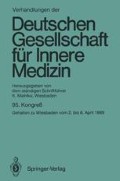Zusammenfassung
Schrittmacherindikationen sind die pathologischen Bradykardien. Wenn die natürliche Erregungsbildung des Herzens versagt, zu versagen droht oder auf inadäquate Frequenzen verlangsamt ist, dann sind die Voraussetzungen zur künstlich-elektrischen Stimulation des Herzens erfüllt.
Access this chapter
Tax calculation will be finalised at checkout
Purchases are for personal use only
Preview
Unable to display preview. Download preview PDF.
Literatur
Brown KA, Maloney JD, Smith CH, Hartzler GO, Ilstrup DM (1980) Carotid sinus reflex in patients undergoing coronary angiography: relationship of degree and location of coronary artery disease to response to carotid sinus massage. Circulation 62:697
Büchner Ch, Thierfelder K (1982) Die klinische Relevanz des Carotisdruckversuchs bei der Indikation zur Schrittmacheranwendung. Herzschrittmacher 2:25
Büchner CH (1984) Anmerkungen zum „Karotissinussyndrom“. In: Alt E, Blömer H (Hrsg) Herzschrittmachertherapie. München
Franke H (1979) Syndrom des hypersensitiven Carotissinus. Dtsch Med Wochenschr 104:541
Holzmann M (1957) Klinische Elektrokardiographie. Thieme, Stuttgart
Kulbertus H, Collignon P (1969) The association of right bundle branch block with left superior or inferior intraventricular block. Its relationship to complete heart block and Stokes-Adams syndrome. Br Heart J 31:435
Langendorf R, Mehiman JS (1947) Blocked (nonconducted) A-V nodal premature systoles imitating first and second degree A-V block. Am Heart J 34:500
Langendorf R (1958) Alternation of A-V conduction time. Am Heart J 55:181
Merx W, Effert S, Hanrath P, Pop T, Rehder W, Schweizer P (1981) Hyperaktiver Carotissinus-Reflex. Dtsch Med Wochenschr 106:135
Mobitz W (1924) Über die unvollständige Stöning der Errungsüberleitung zwischen Vorhof und Kammer des menschlichen Herzens. Z Ges Exp Med 41:180
Schüller H (1988) JT der Deutschen Ges. Herzschrittmacher, München, 1988
Spang K (1957) Rhythmusstörungen des Herzens. Thieme, Stuttgart
Szapo G (1980) Konventionelle und intrakardiale Elektrokardiographie. DOCUMENTA GEIGY
Author information
Authors and Affiliations
Editor information
Editors and Affiliations
Rights and permissions
Copyright information
© 1989 Springer-Verlag, Berlin Heidelberg
About this paper
Cite this paper
Büchner, C., Zehender, M. (1989). Indikationen zur Herzschrittmacherimplantation. In: Miehlke, K. (eds) Verhandlungen der Deutschen Gesellschaft für Innere Medizin. Verhandlungen der Deutschen Gesellschaft für Innere Medizin, vol 95. Springer, Berlin, Heidelberg. https://doi.org/10.1007/978-3-642-83864-4_19
Download citation
DOI: https://doi.org/10.1007/978-3-642-83864-4_19
Publisher Name: Springer, Berlin, Heidelberg
Print ISBN: 978-3-540-51437-4
Online ISBN: 978-3-642-83864-4
eBook Packages: Springer Book Archive

